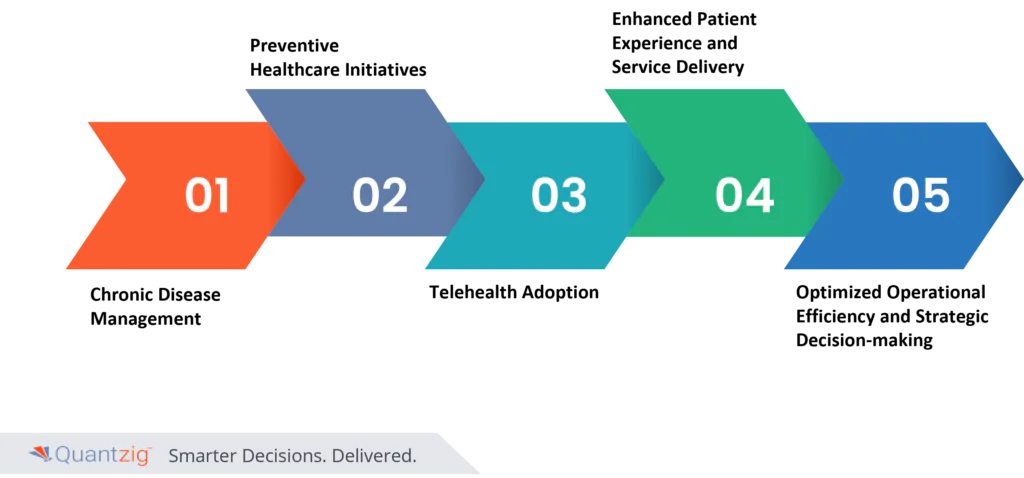Table of Contents
What is Customer Segmentation Solutions in Healthcare?
The concept of customer segmentation solutions is widely accepted across industries such as retail and telecommunications. However, it has recently gained momentum in the healthcare industry as it allows hospitals and healthcare service providers to facilitate patient engagement and enables personalization. An effective customer segmentation strategy offers in-depth patient insights to the organizations in the healthcare industry.
These insights help the players in the healthcare industry to understand their target customer segment market, their preferences, and address their needs to improve community health as a whole significantly. The patients can be segmented in different ways such as risk level and insurance coverage status among other patient demographics. Slowly but steadily healthcare organizations will have to adopt customer segmentation and psychographic segmentation strategies to deliver effective medical care.
Book a demo to experience the meaningful insights we derive from data through our analytical tools and platform capabilities. Schedule a demo today!
Request a DemoTypes of Customer Segmentation
There are numerous approaches to dividing your healthcare market, contingent upon your objectives, resources, and data accessibility.
- Demographic Segmentation: This involves grouping patients based on demographic factors such as age, gender, income level, and education level.
- Psychographic Segmentation: Focuses on the psychological characteristics of patients, including their values, attitudes, and lifestyle.
- Behavioral Segmentation: Segments patients based on their behaviors, such as purchasing patterns or health-related habits.
- Clinical Segmentation: Groups patients based on their medical conditions or health status.
- Needs-Based Segmentation: Identifies patients based on their specific healthcare needs, such as support or autonomy requirements.
- Technology Adoption Segmentation: Segments healthcare providers based on their level of technology adoption.
4 Benefits of Customer Segmentation Solutions in Healthcare:
Healthcare organizations, armed with vast amounts of data from diverse sources, have a unique opportunity to leverage custom segmentation analysis with customer marketing segmentation strategies. This approach goes beyond traditional healthcare practices, offering a plethora of benefits that can revolutionize patient engagement and service delivery across the globe.
| Key Benefit | Description |
|---|---|
| Enhanced Patient Engagement | Personalizes engagement strategies, fostering stronger patient connections and better health management. |
| Targeted Marketing Communication | Enables focused marketing materials, improving campaign effectiveness and patient interactions. |
| Service Customization | Helps tailor services and select suitable providers to meet specific patient needs. |
| Innovation and Product Development | Drives innovation and product development to meet evolving patient expectations. |
Experience the advantages firsthand by testing a customized complimentary pilot designed to address your specific requirements. Pilot studies are non-committal in nature.
Request a proposal nowCustomer Segmentation and Healthcare Industry – Application
The application of customer segmentation in the healthcare industry is multifaceted, influencing various aspects of patient care and organizational strategies. Healthcare customer segmentation stands as a pivotal strategy in today’s intricate Healthcare Consumer Behavior landscape. By integrating various techniques, models, trends, and factors, it allows organizations to understand their patient population better, thereby enhancing service delivery, optimizing costs, Audience Segmentation and improving overall patient well-being. Below are the key points elucidating its applications and significance:
| Category | Main Information |
|---|---|
| 1. Chronic Disease Management | Customer segmentation tailors interventions for chronic conditions. Insights from segmentation and survey analytics enable personalized management of diseases like diabetes and hypertension, focusing on criteria like age, gender, and well-being. |
| 2. Preventive Healthcare Initiatives | Segmentation helps target preventive strategies, using telehealth to reach diverse groups. It promotes proactive health management by analyzing motivations, costs, and techniques. |
| 3. Telehealth Adoption | Segmentation customizes telehealth solutions based on technological preferences and accessibility. Tailored approaches enhance user experience and innovation in healthcare delivery. |
| 4. Enhanced Patient Experience & Service Delivery | Segmentation tailors interventions using demographics, language, and self-care capabilities. Innovations like analytics tools and telehealth improve patient care and accessibility. |
| 5. Optimized Operational Efficiency & Strategic Decision-making | Segmentation streamlines processes, reduces costs, and aligns strategies with patient-centric approaches. Tailored content and data analytics support informed decisions and better communication. |
Get started with your complimentary trial today and delve into our platform without any obligations. Explore our wide range of customized, consumption driven analytical solutions services built across the analytical maturity levels.
Connect with our expertsHealthcare Customer Segmentation: Quantzig Solutions
Quantzig’s team of healthcare customer segmentation experts helped a global healthcare industry player to optimize their sales force and marketing activities to improve their overall ROI. Moreover, the customer segmentation study helped the client to identify growth opportunities, tap market potential, prioritize customers, and improve service quality to ensure long-term customer satisfaction. Read the complete case study.
“Without big data analytics, companies are blind and deaf, wandering out onto the web like a deer on a freeway,” said a leading data analytics expert from Quantzig.
For more than 14 years, we have assisted our clients across the globe with end-to-end data management and analytics services to leverage their data for prudent decision making. Our firm has worked with 120+ clients, including 55+ Fortune 500 companies. At Quantzig, we firmly believe that the capabilities to harness maximum insights from the influx of continuous information around us is what will drive any organization’s competitive readiness and success. Our objective is to bring together the best combination of analysts and consultants to complement our clients with a shared need to discover and build those capabilities and drive continuous business excellence.
Read more: Customer Segmentation Personal Care
Conclusion
In conclusion, healthcare customer segmentation is not just a strategy; it is a transformative approach that can reshape patient engagement, marketing effectiveness, service customization, and innovation using Demographic Segmentation. By understanding the diverse needs of patient populations through segmentation strategies, healthcare organizations can elevate their offerings and provide patient-centric care. The application of customer profile segmentation is a dynamic and ongoing process, ensuring that healthcare providers stay attuned to evolving patient preferences and market dynamics. As the healthcare landscape continues to evolve, the strategic integration of customer segmentation will be a key differentiator in delivering personalized and impactful healthcare services.
Healthcare customer segmentation serves as a cornerstone in shaping the future of healthcare delivery. By integrating various techniques, applications, and considerations, organizations can foster innovation, optimize resources, and enhance patient well-being. As the world evolves, embracing segmentation not only addresses current challenges but also unlocks new opportunities, ensuring a holistic and patient-centric healthcare system.






